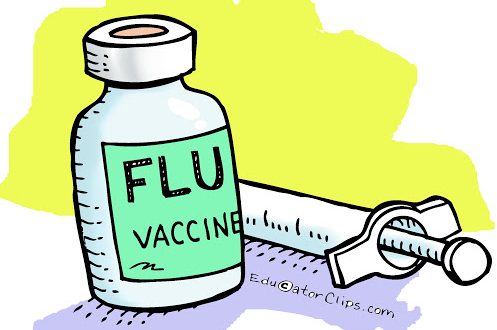Influenza (or the ‘flu’) is a viral infection that is transmitted person to person via airborne ‘droplets’, tiny particles of fluid that are expelled into the air, or onto a surface when an infected person coughs or sneezes.
It affects the respiratory tract, the nose, throat and lungs. It is highly contagious and is attributed to around 3000 deaths in Australia per year. Some flu seasons, like that we experienced in 2017 are worse than other years. This can be attributed to the strains of flu virus that are most prevalent in the community and changes or ‘mutations’ in these virus strains. Viruses are constantly changing, in an attempt to subvert the immune system. Strains of virus that are more successful at this, become dominant and spread. Annual flu vaccines contain three or four of the most prevalent strains for that particular flu season and provide excellent protection against infection but they cannot provide immunity against all strains, or strains that have mutated.
When a person comes in contact with the virus, there may be 1-4 days before they start to exhibit symptoms. This is called the ‘incubation period’. A person may still infect others even if they have not yet started to feel unwell.
Typical symptoms include:
- Fever (sudden onset)
- Dry cough
- Sore throat
- Muscular aches and pains
- Weakness and lethargy
- Nasal congestion
- Chills
- Headaches
- Vomiting & diarrhoea
You will notice many of these symptoms are very similar to those of the common cold, so it can be difficult to tell the difference. Generally, flu symptoms come on very suddenly and can persist for several weeks. Cold symptoms develop more slowly and generally resolve within 4-10 days.
Influenza generally resolves on its own without medical treatment. It is a virus so antibiotics are not effective. Antiviral medications can shorten the length of symptoms, but only if started within the first 48 hours of symptoms presenting. Symptoms can be relieved with mild analgesics, throat lozenges, decongestants, plenty of fluids and plenty of rest.
For some people, a flu infection can be more dangerous, because they are more susceptible to complications such as pneumonia, bronchitis, asthma flares, cardiac problems or bacterial infections. These ‘high risk’ people include those:
- Aged under 5 years or over 65 years of age
- Pregnant women
- People with weakened immune systems
- People with chronic diseases such as diabetes, asthma, heart disease, lung disease or kidney disease
- People who are very obese
- Smokers
- Residents of nursing homes or other aged care facilities
Anyone considered ‘high-risk’ should seek medical attention if they come down with symptoms of flu.
The best ways to protect yourself from flu is to get vaccinated. The vaccine provides greatest protection for 3-4 months post administration after which its protective benefits begin to wane. Be vigilant with washing or disinfecting your hands especially if you work with groups of people, take public transport or use public-use equipment & facilities.




